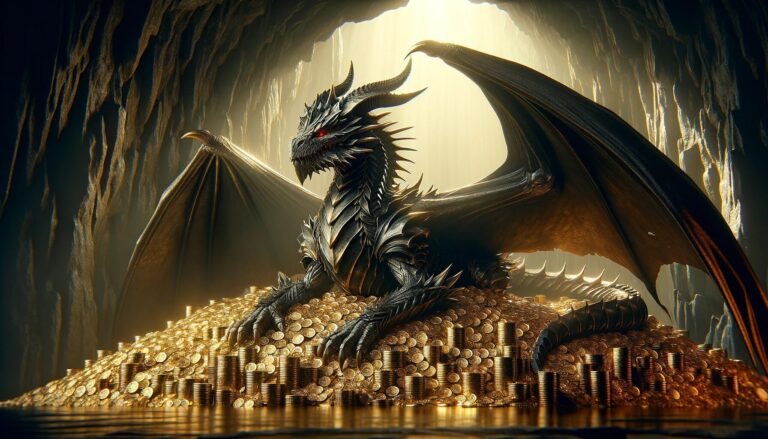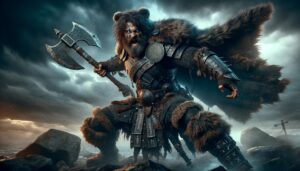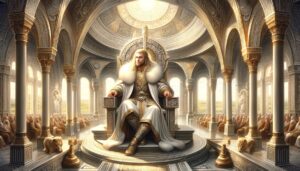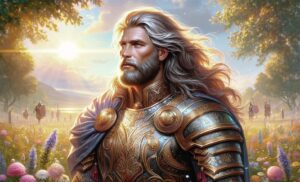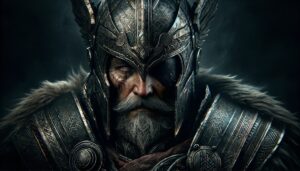Table of Contents
In the rich tapestry of Norse mythology, the story of Fafnir the dragon is a captivating and cautionary tale of greed, transformation, and ultimate downfall. Furthermore, Fafnir, born from the lineage of the Aesir and the Vanir, is a creature whose tale is woven into the very fabric of Norse legend.
Origins and Family
Fafnir’s story begins with his family, a lineage of complex relationships and divine ancestry. He was the son of Hreidmar, a powerful dwarf, and brother to Regin and Otr. Hreidmar, his father, was renowned for his skill in crafting precious objects, especially his magical cauldron known as the “Otter’s Ransom.” The family’s wealth was significant, but it was their greed that ultimately set the stage for Fafnir’s transformation.
The story takes a tragic turn when Loki, the mischievous Norse god, kills Otr in the form of an otter and presents the pelt to Hreidmar as compensation. Fearing retribution for his actions, Loki demands that the otter’s pelt be filled with gold to cover Otr’s body. This sets in motion a series of events that leads to the accumulation of immense wealth within Fafnir’s family. It is this hoarding of wealth and the ensuing greed that eventually transforms Fafnir into the dragon we know today.
Appearance
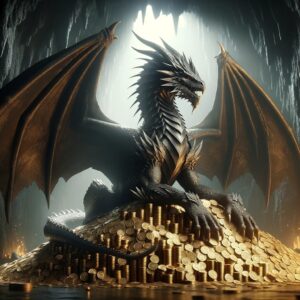
Size: Fafnir is depicted as an enormous dragon, often of gigantic proportions. His size is meant to emphasize his formidable nature.
Scales: His body is covered in thick, impenetrable scales that shimmer with a dark, foreboding hue. These scales serve as natural armor, making him nearly invulnerable to attacks.
Fafnir possesses powerful wings that allow him to soar through the skies with a grace.
Claws: His limbs are equipped with sharp, clawed appendages that can shred through obstacles and foes with ease.
Eyes: Fafnir’s eyes are often described as burning with an eerie, malevolent fire. This fiery gaze reflects his inner corruption and insatiable greed.
His mouth contains rows of razor-sharp teeth, which, when combined with his ability to breathe fire, make him a formidable opponent in battle.
Abilities
Fafnir’s transformation not only alters his appearance but also grants him formidable abilities befitting a dragon of his stature. Among his most notable powers are his fiery breath and his incredible strength. His fiery breath can reduce anything it touches to ashes, making him a formidable adversary to any who dare to challenge him.
In addition to his physical prowess, Fafnir possesses an uncanny ability to amass and guard vast treasures. His hoard, a symbol of his avarice, is said to be so vast that it defies imagination. This hoard includes not only the gold and riches acquired through his family’s misfortunes but also the countless treasures stolen from those who sought to claim his wealth. Fafnir’s ability to protect this hoard is as legendary as his greed, and he is known to go to great lengths to safeguard his treasures from would-be thieves.
Symbols
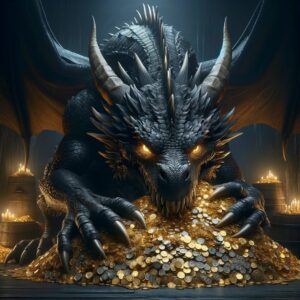
Fafnir’s symbols are a reflection of his transformation and his insatiable greed. One of the most prominent symbols associated with him is the image of a dragon, often depicted with scales, sharp claws, and a menacing demeanor. This dragon symbolizes not only Fafnir’s physical form but also the destructive force of greed that can corrupt even the noblest of beings.
Another symbol closely associated with Fafnir is the image of a treasure hoard, overflowing with gold, jewels, and other precious artifacts. This symbolizes his relentless accumulation of wealth and the lengths to which he will go to protect it. The hoard is often depicted as a tantalizing prize, tempting those who seek unimaginable riches but leading them down a treacherous path to their doom.
Myths and Stories
The Fafnir Saga
Fafnir had once been a dwarf, the son of Hreidmar, renowned for crafting the magical cauldron known as the “Otter’s Ransom.” Greed, however, drove Fafnir’s family to accumulate vast wealth, including the cursed gold-filled otter’s pelt.
This avarice transformed Fafnir into the monstrous dragon, a reflection of his inner corruption. He hoarded treasures stolen from those who sought his wealth, growing increasingly paranoid and reclusive.
Sigurd’s heroic act not only ended Fafnir’s life but also broke the curse of greed that had consumed him. The dragon’s hoard was left to those who were just and worthy, a reminder that true wealth is not measured in material possessions alone.
Modern culture

Fafnir, the iconic dragon from Norse mythology, has left an indelible mark on modern culture. You can encounter references to Fafnir in various forms of media, literature, and even pop culture. Here are a few examples:
Literature: Fafnir’s influence can be found in numerous modern fantasy novels and books. One prominent example is J.R.R. Tolkien’s “The Hobbit,” where the character Smaug, a dragon who hoards treasure, draws clear inspiration from Fafnir. Tolkien, a scholar of Norse mythology, was undoubtedly influenced by Fafnir’s story when creating Smaug.
Video Games: Fafnir appears as a character or inspiration in various video games. In the “Final Fantasy” series, there is a recurring character named Fafnir, often depicted as a dragon or dragon-like creature. In the game “Smite,” Fafnir is a playable character, drawing directly from Norse mythology.
Film and Television: Fafnir’s story has inspired several film and TV adaptations. In the TV series “Lost Girl,” Fafnir appears as a dragon character. Additionally, the character Fafnir Dwarven in the anime and manga series “Miss Kobayashi’s Dragon Maid”.
Art and Illustrations: Contemporary artists often draw inspiration from mythology, and Fafnir is a popular subject for artistic interpretation. You can find various illustrations and artworks featuring Fafnir in online galleries and exhibitions.
Role-Playing Games (RPGs): Fafnir’s name, image, or concept often finds its way into RPGs. In the “Dungeons & Dragons” tabletop game, for instance, there are creatures and adventures inspired by Norse mythology.
FAQ
What caused Fafnir's transformation?
Greed and a cursed hoard of gold transformed Fafnir from a dwarf into a dragon.
What are Fafnir's abilities?
Fafnir can breathe fire, possesses immense strength, and guards his treasure hoard fiercely.
What's Fafnir's significance in Norse mythology?
Fafnir's story is a cautionary tale about the consequences of unchecked avarice.
How Fafnir look like?
Fafnir is portrayed as an enormous dragon with impenetrable scales, fiery eyes, sharp claws, and wings.
What famous story involves Fafnir?
The epic tale of Sigurd and Fafnir narrates their battle and Fafnir's eventual downfall.
